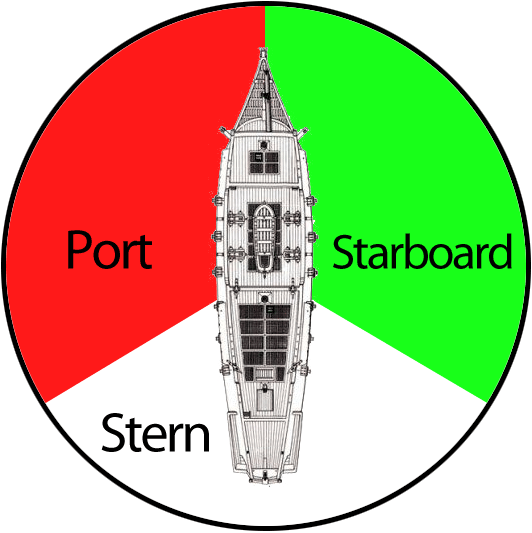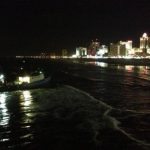Seamanship is not confusing. It’s just a study of simple concepts, like knowing the difference between left and right. (Or is it port and starboard?) Oh well, no matter, we’ll get all that ironed out today, and you’ll be well on your way to impressing your friends and neighbors with your vast knowledge of directional concepts.
Let’s start with the fact that at least two navigation lights on your vessel are designed to be visible to anyone approaching you from any direction between “head-on” and “22.5 degrees abaft the beam.” That means that anyone coming from any point between “dead ahead” and “a little ways behind a line through the widest part of your boat side to side” should be able to see one or both of those lights. One of those lights is red, and the other is green. The red light is on the left, or port side of your boat, and covers an arc of 112.5 degrees. The other is green, and is on the starboard, or right side. So let’s find an easy way to remember this. Red, port and left all are short words. Green is a longer word, as is starboard and right. Easy as pie, this seamanship stuff.
Now that we’re on a roll, let’s tackle “Red Right Returning.” This phrase has been in use since long before I was a buoy. It serves as a tool to help understand and remember the concept of navigation where aids to navigation (ATONS) are marking channels, navigable waterways, harbors and other areas of safe or unsafe waters. It simply says that, when returning from the sea, keep the red navigation aids (buoys, daymarks, lights) on your right when passing by them. So, if I’m coming into a harbor from the sea, or heading up the Mississippi from the Gulf, I’ll keep red ATONS on my right, and green ones on my left. We could say “Keep the Green on your Right When Heading Back Out to Sea,” but that doesn’t quite have the ring to it as “Red Right Returning.”
So let’s see, what do we have so far? When returning from the sea, keep the red buoys on your right side. But when you take the lenses off your navigation lights to clean them, you make sure you put the red lens back on the left side where it belongs. Hmmm. We can handle that. Let’s move on.
Next, let’s navigate a river. We’re piloting our boat up the Mississippi, with Illinois (east of the river) on our right bank, and Iowa (west of the river) on our left bank. Not quite. Convention dictates that riverbanks are always named as if the direction of travel is downstream. Therefore, as we travel up the river, the right bank is really the left bank, and the left bank is really the right bank. Of course, this concept is much easier to grasp if you’re traveling downstream, which I encourage you to do whenever possible. It saves fuel, and it’s easier to remember which bank is which.
Now we’re traveling up the river, our red navigation light is on our port side, the red buoys are on our starboard side, and the right bank is on our left.
Soon, in a narrow part of the river, we approach the stern (that’s the back) of another vessel, going slower than we are, and we decide to pass. Inland Navigation Rules state that we should sound one short blast of our horn if we intend to “overtake you on your starboard (right) side.” But we don’t want to stray too far to the right of him, since we know the red buoys are over there, on our right as we are returning from the sea. This, of course, means we’ll be looking over the left side of the boat at him as we pass, you know, the side with the red light. And if it’s at night, you’ll eventually see his green light during the overtaking maneuver, and you will know when it first appears that you are indeed 22.5 degrees abaft his beam. You’ll want to be sure to note that important event in your logbook. (Just joshing about the logbook entry.)
And one last thing to remember, and then you’ll have many of the right-left boating concepts embedded forever in your subconscious where they belong. If you are out on an open body of water, and you see a boat approaching from your left, you generally have the right-of-way. To the other boat, you are in his “danger zone,” and he must give way. He knows you’re in his danger zone because he sees your red light on the left side of your boat, as he peers over the right side of his.
I think that’s right, anyway.







